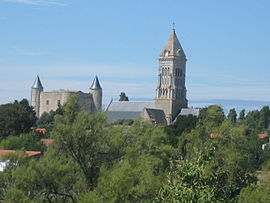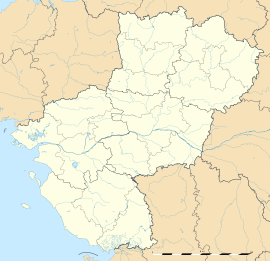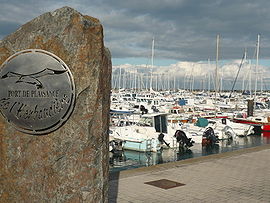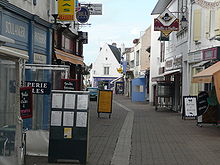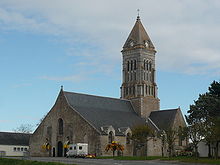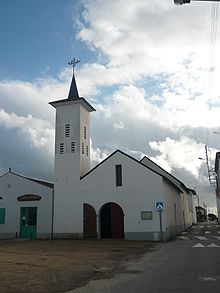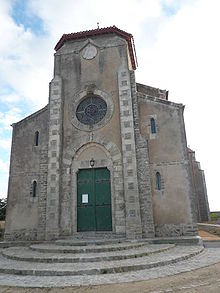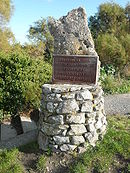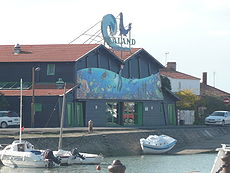- Noirmoutier-en-l'Île
-
Noirmoutier-en-l'Île

Administration Country France Region Pays de la Loire Department Vendée Arrondissement Les Sables-d'Olonne Canton Noirmoutier-en-l'Île Mayor Noël Faucher
(2008–2014)Statistics Elevation 0–20 m (0–66 ft)
(avg. 7 m/23 ft)Land area1 19.59 km2 (7.56 sq mi) Population2 5,000 (2006) - Density 255 /km2 (660 /sq mi) INSEE/Postal code 85163/ 85330 1 French Land Register data, which excludes lakes, ponds, glaciers > 1 km² (0.386 sq mi or 247 acres) and river estuaries. 2 Population without double counting: residents of multiple communes (e.g., students and military personnel) only counted once. Coordinates: 47°00′16″N 2°15′12″W / 47.0044°N 2.2533°W
Noirmoutier-en-l'Île, commonly referred to as Noirmoutier, is a commune located in the northern part of the island of Noirmoutier, just off the coast of the Vendée department in the Pays de la Loire region in western France.
The history of the town began with the arrival of the monk Saint Philibert in 674 who founded a monastery. The Château de Noirmoutier dates from the 11th and 12th century. In summer the area is a tourist resort.
Contents
Geography
Noirmoutier-en-l'Île is situated to the north of the island of Noirmoutier, in the Atlantic Ocean. The commune covers the northern point of the island, and contains three villages: Noirmoutier, L'Herbaudiere and Le Vieil. L'Herbaudiere is a noted port and is managed by the Chamber of Commerce and Industry of the Vendée.[1] The unusual location relative to the town and economic might of the village encouraged from time to time its inhabitants to seek the establishment of an independent commune from Noirmoutier-en-l'Île. Le Vieil is also located on the north coast within the commune, and is a typical village consisting of houses on traditional narrow lanes. During the summer it becomes a resort with holidaymakers. An inventor Brutus de Villeroi tested the first French submarine in the village on 12 August 1832.[2] An old street bears his name.
Economy
Cuisine
Noirmoutier is home to the most expensive potatoes in the world.[3][4] Known as "La Bonnotte", only around 100 tons of this top quality potato are cultivated annually and it is harvested only on the island Noirmoutier. The cost of one kilogram can reach €500 (US $322 per pound), but the potatoes are normally sold for around €70 per kilo (US $45 per pound). The cost is attributed to the fact that this type of potato is almost extinct because it must be harvested by hand.[5] The potato fields also require fertilization by seaweed in a climate shaped by the nearby sea. The presence of algae and seaweed in the soil is responsible for the potato's earthy and salty flavor. Because the variety is delicate and its tuber remains attached to its stem, the potato must be picked and not torn. [5] The potatoes are generally served in top class restaurants in France and the Netherlands in mid May.
The commune is also known for its seafood dishes such as the Saint Gilles Croix de Vie barbecue grilled sardine and the baked germon tuna or mussels of the Bay de l’Aiguillon cooked in mouclade. Mojette beans, as with the rest of the region, are eaten with a knob of butter or as a side dish with ham, duck or lamb. The wines of the Vendean Strongholds date back to the Middle Ages. Brem sur Mer, Pissotte, Mareuil sur Lay et Vix are notable wines that belong to the DWHQ category (Delimited Wines of Higher Quality).[6]
The commune was also part of the 2005 Tour de France and 2011 Tour de France.
Landmarks
The Château de Noirmoutier is one of the town's major landmarks and is run by the commune government, It has been listed as a monument historique by the French Ministry of Culture since 1992.[7]
The first traces of the castle appeared in 830 with the construction of a castrum by the abbot Hilbold, from the monastery of Saint-Philbert. It served to defend the monks and the island's population from the Vikings.
The castle was rebuilt in stone in the 12th century by the feudal power who was trying to stabilise the region, notably by preventing Norman pillaging. The island at that time was under the control of the barons of La Garnache. The keep was built by Pierre IV of La Garnache, then an enclosure equipped with towers was built around the lower courtyard.The castle resisted numerous attacks from the English in 1342 and 1360, and again in 1386 under the command of the Earl of Arundel It fought off the Spanish in 1524 and 1588, but in 1674, it was taken by the Dutch troops of Admiral Tromp.
In the 16th century, the castle was held by the La Trémoille family, then viscounts of Thouars.[8] The castle was sold in 1720 to Louis IV Henri de Bourbon-Condé who resold it in 1767 to Louis XV.
During the French Revolution, the castle served as a military prison. During the 19th century, the castle was used as a barracks. In 1871, during the Paris Commune, insurgents were imprisoned there. In 1960, a house was built within the castle grounds by the governor of the island and the castle. Today, the keep houses the Noirmoutier Museum.
The keep at the centre of the castle is solid and rectangular. Built of rubble, it has three floors with the lords' residence at the top. The keep has numerous murder holes and defensive turrets at the corners. The rectangular fortification consists of two towers, a single gate and two watch turrets in the four corners. At the beginning of the 18th century, the towers were reconstructed and the keep adapted for artillery.
The Parish Church of Noirmoutier is dedicated to St. Philbert, who founded a monastery here around 674.[9] where the monks' s had taken refuge after the invasion of Normandy in 875. A shrine at the altar contains relics of the saint and was classified as a historical monument in 1898. The church was first destroyed by the Saracens in 725 and 732. When the son of Charlemagne, Louis the Pious became King of Aquitaine, he inherited the rights to the church and in 801 ordered the reconstruction of the abbey and chapel. Forty five years later it was again destroyed by the Normans in 846. It was then rebuilt at the end of 11th century but rather more primitively than previously. Centuries later, the aisles were raised and it was consecrated in 1849. The neo-Romanesque bell tower was built in 1875 to replace the old bell tower which was destroyed by fire in 1848.
On the inside is a model frigate, made by an artisan watchmaker of the village in 1802 for Augustus Jacobsen. The church received the body of St. Philbert some time between 690 and 836, when he was transferred to Saint-Philbert-de-Grand-Lieu,[9] where the monks had taken refuge after the invasion of Normandy in 875. A shrine at the altar contains relics of the saint and was classified as a historical monument in 1898.
- Jacobsen Dam was built in 1812 by John Cornelius Jacobsen, descendant of a family of Dutch who came to the area in the eighteenth century . This dam has allowed the development of salt marsh s,[6] creating a towpath and a channel to access the port. Along the channel is the graveyard of ships. On the other side of the pier, in the marshes is a noted bird habitat with waterfowl such as Brant and Little Egret. At the end of the pier there are facilities for cycling and pedestrians.
- La chapelle de la Pitié : Meaning "The Chapel of Mercy": There is a stele in memory of Jacobsen, creator of the dam, and the events of 3 January 1794 are recalled, when the sland was attacked by the Republican troops, who killed 1500 Vendée prisoners, despite promising to pardon them.
- L'Hôtel Jacobsen : The Jacobsen Hotel is the largest building of Noirmoutier. It was built between 1761 and 1766 by Cornils Guislain-Jacobsen who had been in the town since 1740.
- Hôtel Boucheron ou Lebreton des Grapillières': It was built in 1767, by the merchant François Boucheron.[10] In 1790, the hotel became the property of the merchant Lebreton des Grapillières, who gave his name to the building. It was the headquarters of the customs administration in the nineteenth century, and tourist hotel called the Hotel d'Elba, after Napoleon's expulsion to Elba.
- Chapelle de Le Vieil
- Eglise de l'Herbaudière
- Noirmoutier-en-l'Île Sealand Aquarium
- Pointe aux Dames Lighthouse
Personalities
- Pierre-Louis Lebreton (1752–1801), merchant, Mayor of Noirmoutier from 1792 to 1798.
- Édouard Richer, historian, specializing in the history of Brittany.
In memory of Jacobsen Port Town Hall Noirmoutier-en-l'Île Sealand Aquarium Sister city
 Crestview, FL, United States
Crestview, FL, United States
See also
References
- ^ Chambre de commerce et d'industrie de la Vendée, Retrieved on August 15, 2009.
- ^ Bibliographie annuelle de l'histoire de France. Comité français des sciences historiques, Centre national de la recherche scientifique (France), University of Michigan. 1995. http://books.google.co.uk/books?id=3cbfAAAAMAAJ&dq=Brutus+de+Villeroi+noirmoutier.
- ^ Guinness World Records 2008. Guinness. 2008.
- ^ (French) "La Pomme de Terre primeur de l'ile de Noirmoutier". Coopérative Agricole de Noirmoutier. http://www.labonnottedenoirmoutier.com/. Retrieved August 26, 2009.
- ^ a b "Cultivation". La Bonnotte de Noir Moutier. http://www.labonnottedenoirmoutier.com. Retrieved August 15, 2009.
- ^ a b "Fromentine - Noirmoutier-en-l'Ile". TV5 Monde. http://tv5monde.org/TV5Site/tour2005/etape_en.php?id=1. Retrieved August 15, 2009.
- ^ "Monuments historiques". French Ministry of Culture. http://www.culture.gouv.fr/public/mistral/merimee_fr?ACTION=RETROUVER&FIELD_1=INSEE&VALUE_1=85163&NUMBER=2&GRP=0&REQ=%28%2885163%29%20%3aINSEE%20%29&USRNAME=nobody&USRPWD=4%24%2534P&SPEC=9&SYN=1&IMLY=&MAX1=1&MAX2=100&MAX3=100&DOM=Tous. Retrieved August 15, 2009.
- ^ "1631 - 1765 - La famille La Trémoille dans la Gazette de Th. Renaudot" (in French). Histoire Passion. http://www.histoirepassion.eu/spip.php?article708.
- ^ a b "Churches and Chapels". www.the-vendee.co.uk. http://www.the-vendee.co.uk/churchchap.htm. Retrieved August 15, 2009.
- ^ "Hôtel du Général d'Elbée". generaldelbee.com. http://www.generaldelbee.com/historiqueuk.htm. Retrieved August 15, 2009.
 Côte de Lumière
Côte de Lumière  Noirmoutier-en-l'Ile · Barbâtre · La Barre-de-Monts · Notre-Dame-de-Monts · Saint-Jean-de-Monts · Saint-Hilaire-de-Riez · Saint-Gilles-Croix-de-Vie · Bretignolles-sur-Mer · Brem-sur-Mer · Olonne-sur-Mer · Les Sables d'Olonne · Château-d'Olonne · Talmont-Saint-Hilaire · Jard-sur-Mer · Saint-Vincent-sur-Jard · Longeville-sur-Mer · La Tranche-sur-Mer · La Faute-sur-MerCategories:
Noirmoutier-en-l'Ile · Barbâtre · La Barre-de-Monts · Notre-Dame-de-Monts · Saint-Jean-de-Monts · Saint-Hilaire-de-Riez · Saint-Gilles-Croix-de-Vie · Bretignolles-sur-Mer · Brem-sur-Mer · Olonne-sur-Mer · Les Sables d'Olonne · Château-d'Olonne · Talmont-Saint-Hilaire · Jard-sur-Mer · Saint-Vincent-sur-Jard · Longeville-sur-Mer · La Tranche-sur-Mer · La Faute-sur-MerCategories:- Communes of Vendée
- 674 establishments
Wikimedia Foundation. 2010.

